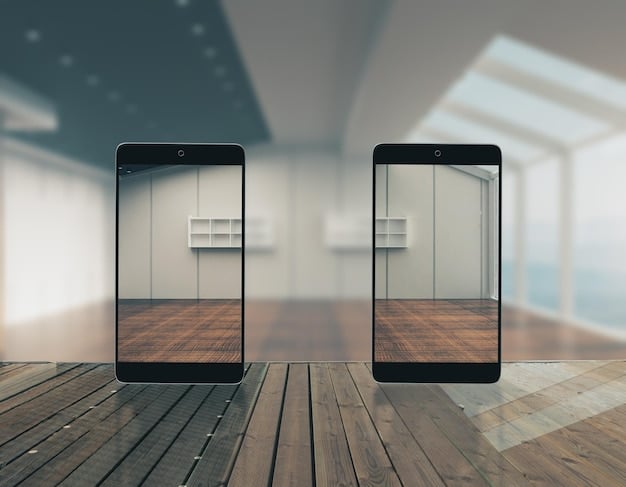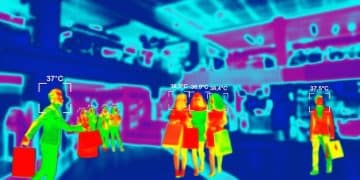Boost Sales by 15% with Mobile AR/VR Commerce in the US

Mobile AR/VR commerce in the US offers immersive shopping experiences that can increase sales by 15%, leveraging augmented and virtual reality technologies to enhance customer engagement and satisfaction.
Ready to revolutionize your mobile commerce strategy? Discover how integrating mobile AR/VR commerce: Enhance the Shopping Experience and Increase Sales by 15% with Immersive Technologies in the US can transform customer engagement and drive significant revenue growth for your business.
Understanding Mobile AR/VR Commerce in the US
Mobile AR/VR commerce is changing how US consumers shop by offering immersive and interactive experiences. This technology allows customers to visualize products in their own environment or virtually try them on, all through their mobile devices.
The Basics of Augmented Reality (AR)
Augmented reality overlays digital information onto the real world, enhancing the user’s perception. In mobile commerce, AR can be used to visualize furniture in a home, try on clothes virtually, or see how makeup looks before purchasing.
Exploring Virtual Reality (VR) in Commerce
Virtual reality creates a completely immersive digital environment. While less common in mobile commerce due to hardware requirements, VR can offer unique shopping experiences, such as virtual store tours or product demonstrations.
- Enhanced Product Visualization: AR/VR allows customers to see products in detail before buying.
- Increased Customer Engagement: Immersive experiences keep customers engaged and interested.
- Higher Conversion Rates: Virtual try-ons and in-home visualizations lead to more confident purchases.
- Competitive Advantage: Early adoption of AR/VR sets brands apart from competitors.
Mobile AR/VR commerce is rapidly evolving, with more retailers adopting these technologies to improve the shopping experience and drive sales growth. The US market is particularly receptive, with consumers eager to try new and innovative shopping methods.
Benefits of Implementing AR/VR in Mobile Commerce
Integrating AR/VR into your mobile commerce strategy offers numerous benefits, from increased sales to improved customer satisfaction. These technologies create engaging and personalized shopping experiences that can drive significant results.
Boosting Sales and Conversion Rates
One of the primary benefits of AR/VR is the potential to increase sales. By allowing customers to virtually try products or visualize them in their own space, AR/VR reduces purchase uncertainty and boosts conversion rates.
Enhancing Customer Engagement and Satisfaction
AR/VR provides immersive and interactive experiences that capture customer attention and keep them engaged. This leads to higher satisfaction levels and stronger brand loyalty.

- Personalized Shopping Experiences: AR/VR allows for tailored product recommendations and customized visualizations.
- Reduced Return Rates: By providing a more accurate product representation, AR/VR minimizes the likelihood of returns.
- Increased Brand Awareness: Innovative AR/VR experiences generate buzz and increase brand visibility.
- Data-Driven Insights: AR/VR interactions provide valuable data on customer preferences and behavior.
Implementing AR/VR in mobile commerce not only enhances the shopping experience but also provides a competitive edge. Retailers that embrace these technologies are better positioned to attract and retain customers in a rapidly evolving market.
Key Applications of AR/VR in Mobile Retail
AR/VR technologies are finding diverse applications across various retail sectors. From fashion to furniture, these immersive experiences are transforming how consumers interact with products and brands.
Virtual Try-On Experiences in Fashion and Beauty
AR-powered virtual try-on features allow customers to see how clothes, accessories, or makeup look on them without physically trying them on. This is particularly useful for online shoppers who want to avoid the hassle of returns.
In-Home Product Visualization for Furniture and Decor
AR apps enable customers to visualize furniture and decor items in their own homes before making a purchase. This helps them assess the size, style, and fit of the products in their living spaces.
- Automotive Showrooms: VR can create virtual showrooms where customers can explore different car models and features.
- Real Estate Tours: AR/VR allows potential buyers to take virtual tours of properties from anywhere in the world.
- Interactive Product Catalogs: AR can bring product catalogs to life with interactive 3D models and animations.
The applications of AR/VR in mobile retail are constantly expanding, with new and innovative use cases emerging regularly. Retailers that embrace these technologies can create unique and memorable shopping experiences that drive customer loyalty and sales growth.
Challenges and Solutions for AR/VR Implementation
While AR/VR offers significant benefits, implementing these technologies in mobile commerce also presents several challenges. Addressing these challenges is crucial for successful adoption and maximizing the ROI of AR/VR investments.
Technical Complexity and Integration Issues
Integrating AR/VR technologies into existing mobile commerce platforms can be technically complex. Retailers need to ensure seamless integration with their systems and provide a smooth user experience.
High Development Costs and ROI Uncertainty
Developing high-quality AR/VR experiences can be expensive, and the ROI may not be immediately apparent. Retailers need to carefully plan their AR/VR investments and track their performance to ensure a positive return.

Solutions:
- Partnering with AR/VR Experts: Retailers can leverage the expertise of specialized AR/VR development companies.
- Starting with Simple Use Cases: Begin with basic AR/VR applications and gradually expand as you gain experience.
- Focusing on User Experience: Ensure that AR/VR experiences are intuitive, engaging, and add value to the shopping journey.
- Measuring and Analyzing Results: Track key metrics such as conversion rates, engagement levels, and customer satisfaction to optimize AR/VR strategies.
By addressing these challenges and implementing effective solutions, retailers can successfully integrate AR/VR into their mobile commerce strategies and unlock the full potential of these immersive technologies.
Measuring the Success of AR/VR Commerce Initiatives
To ensure that your AR/VR commerce initiatives are delivering the desired results, it’s essential to track and measure their performance. Key metrics can provide valuable insights into the effectiveness of your AR/VR strategies and guide future improvements.
Key Performance Indicators (KPIs) to Track
Several KPIs can be used to measure the success of AR/VR commerce initiatives, including conversion rates, engagement levels, customer satisfaction, and return on investment.
Analyzing Customer Engagement and Behavior
AR/VR interactions provide valuable data on customer behavior and preferences. By analyzing this data, retailers can gain insights into what works and what doesn’t, and optimize their AR/VR experiences accordingly.
Metrics to Consider:
- Conversion Rates: Track the percentage of customers who make a purchase after using AR/VR features.
- Engagement Time: Measure how long customers spend interacting with AR/VR experiences.
- Customer Satisfaction Scores: Gather feedback on customer satisfaction with AR/VR features.
- Return Rates: Monitor whether AR/VR helps reduce product returns.
By carefully tracking and analyzing these metrics, retailers can gain a clear understanding of the impact of their AR/VR commerce initiatives and make data-driven decisions to improve their performance.
The Future of Mobile AR/VR Commerce in the US
The future of mobile AR/VR commerce in the US is promising, with continued advancements in technology and growing consumer adoption. As AR/VR capabilities improve and become more accessible, we can expect to see even more innovative applications in the retail sector.
Emerging Trends and Technologies
Several emerging trends are shaping the future of mobile AR/VR commerce, including advancements in 5G connectivity, improved AR/VR hardware, and the integration of artificial intelligence (AI).
Predictions for the Next 5 Years
Over the next five years, we can expect to see wider adoption of AR/VR in mobile commerce, with more retailers offering immersive shopping experiences. AR/VR will become more seamless and integrated into the shopping journey, enhancing customer engagement and driving sales growth.
Future Trends:
- AI-Powered Personalization: AR/VR experiences will become more personalized with the help of AI.
- Social AR/VR Commerce: Customers will be able to shop and interact with products together in virtual environments.
- Increased Use of 5G: Faster connectivity will enable more seamless and immersive AR/VR experiences.
- AR/VR in Physical Stores: AR/VR will bridge the gap between online and offline shopping, enhancing the in-store experience.
As AR/VR technologies continue to evolve, retailers in the US will have even more opportunities to create innovative and engaging shopping experiences that drive customer loyalty and sales growth. Embracing these technologies will be crucial for staying competitive in the rapidly evolving mobile commerce landscape.
| Key Point | Brief Description |
|---|---|
| 🚀 Increased Sales | AR/VR enhances product visualization, boosting conversion rates. |
| ✨ Engagement | Immersive experiences capture attention and improve brand loyalty. |
| 🛍️ Applications | Virtual try-ons and in-home visualizations enhance retail experiences. |
| 💡 Future Trends | AI-powered personalization and social AR/VR commerce are emerging. |
FAQ
Mobile AR commerce refers to using augmented reality technology on mobile devices to enhance the shopping experience. Customers can virtually try products or visualize them in their environment before purchasing.
AR/VR increases sales by reducing purchase uncertainty. Virtual try-ons and in-home visualizations allow customers to make more informed decisions, which boosts conversion rates and reduces returns.
The main challenges include technical complexity, high development costs, and the need for seamless integration with existing systems. Retailers need to carefully plan and invest in AR/VR initiatives.
Industries such as fashion, beauty, furniture, and automotive benefit significantly from AR/VR commerce. These technologies allow customers to virtually interact with products and visualize them in their own space.
The future holds wider adoption of AR/VR, AI-powered personalization, and social AR/VR commerce. Expect more seamless and integrated AR/VR experiences that enhance customer engagement and drive sales growth.
Conclusion
In conclusion, mobile AR/VR commerce: Enhance the Shopping Experience and Increase Sales by 15% with Immersive Technologies in the US presents a transformative opportunity for retailers to elevate customer engagement and drive sales growth. By embracing these innovative technologies and addressing the associated challenges, businesses can create unique and personalized shopping experiences that resonate with today’s tech-savvy consumers.





